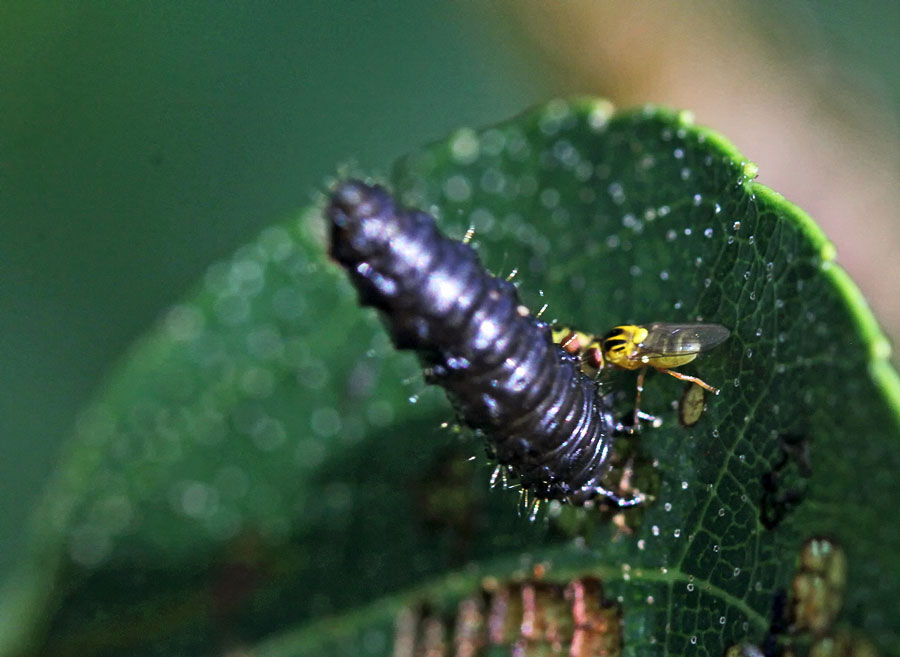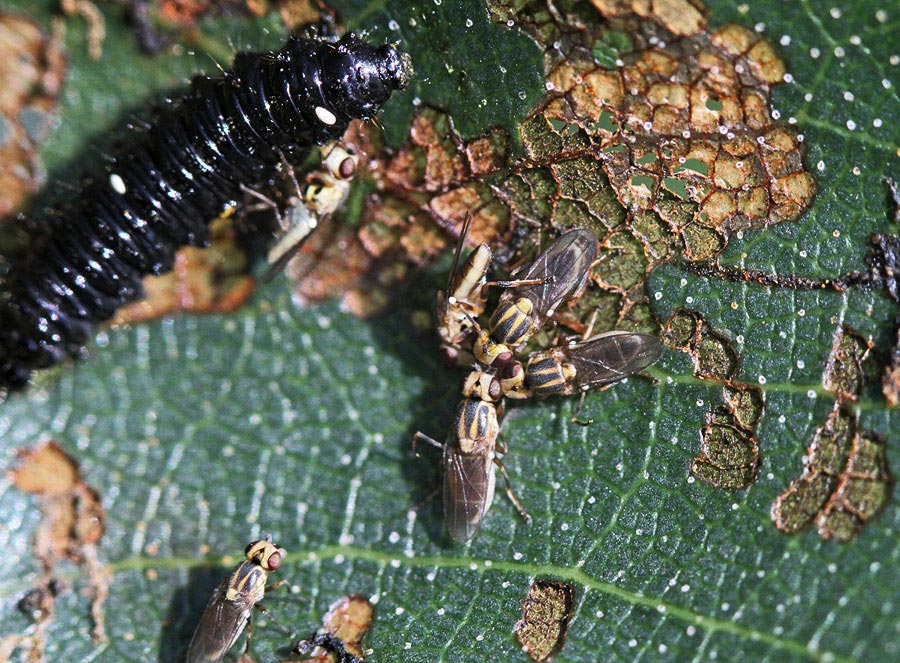Diptera.info :: Identification queries :: Diptera (adults)
|
Chloropidae versus Agelastica alni larvae
|
|
| pat_der2003 |
Posted on 01-08-2012 18:40
|
|
Member Location: Paris area, France Posts: 1731 Joined: 20.08.07 |
Bonjour, On Sunday July 22/2012 morning, I shoot those Agelastica alni larva on Alnus cordata's leaf. And on one of these leaves I saw this scene : pat_der2003 attached the following image:  [79.78Kb] |
| pat_der2003 |
Posted on 01-08-2012 18:46
|
|
Member Location: Paris area, France Posts: 1731 Joined: 20.08.07 |
You can easily imagine on the second picture (see below) the raise of the larva : is it due to larvae's irritation from the sucking of the Chloropidae or is it some kind of deed seen in Coccinellidae's larva when they are pupating (sudden raise) ?
pat_der2003 attached the following image:  [85.18Kb] |
| pat_der2003 |
Posted on 01-08-2012 18:49
|
|
Member Location: Paris area, France Posts: 1731 Joined: 20.08.07 |
far about 4 cm from the previous scene, I saw too this scene :
pat_der2003 attached the following image:  [174.61Kb] Edited by pat_der2003 on 01-08-2012 18:53 |
| pat_der2003 |
Posted on 01-08-2012 18:56
|
|
Member Location: Paris area, France Posts: 1731 Joined: 20.08.07 |
Could the two eggs laid on Agelastica alni's larva be Chloropidae's one ? Or should they be more obviously Tachinidae's eggs (or some kind of parasitic flies) ? Thanks in advance !!! Edited by pat_der2003 on 01-08-2012 18:56 |
| Sundew |
Posted on 01-08-2012 23:40
|
|
Member Location: Berlin and Baden-Württemberg, Germany Posts: 3938 Joined: 28.07.07 |
Here (http://www.olivie...010/07/23/) we have the same situation and some explanation. It is probably based on that text: http://www.zin.ru...00/16.html. I don't think that the big eggs belong to the Chrysomelids. Here (http://www.comman....alni.html) Tachinids as well as wasps are listed as possible parasites. |
|
|
|
| pat_der2003 |
Posted on 06-08-2012 19:07
|
|
Member Location: Paris area, France Posts: 1731 Joined: 20.08.07 |
Oh thank you very much, sundew !!  I'm glad to read that Olivier M. observed the same scene previously !! I 'll contact him to know if he got some more informations !!!  |
| rvanderweele |
Posted on 04-07-2013 18:28
|
|
Member Location: Leiden, the Netherlands Posts: 1988 Joined: 01.11.06 |
This evening, while hunting for Platypalpus, I observed the same! A few tiny Chloropidae were very active on and around the larvae of Agelastica alni. I caught one, my first Chloropidae I ever collected on purpose!!!! What is the species? The article mentioned in the other postings cannot be downloaded any more. I would like to have it. Can someone please send a copy to me? ruud van der weele rvanderweele@gmail.com |
|
|
|
| rvanderweele |
Posted on 04-07-2013 18:29
|
|
Member Location: Leiden, the Netherlands Posts: 1988 Joined: 01.11.06 |
Ah, Thaumatomyia notata
ruud van der weele rvanderweele@gmail.com |
|
|
|
| von Tschirnhaus |
Posted on 07-07-2013 19:40
|
|
Member Location: Bielefeld, Germany Posts: 454 Joined: 04.11.07 |
Really, the first scene shows an assemblage of Thaumatomyia notata (Meigen), Chloropidae [compare many comments on other pictures]. Pschorn-Walcher, H. (1956) Chloropiden als Kostgänger von Chrysomelidenlarven. – Zoologischer Anzeiger 156: 318-319, reported just the same observation and he mentioned a second species, Lasiosina albipila (Loew , 1866) feeding together with T. notata. In the 2nd scene several Lasiosina specimens (possibly also albipila) are present. The upper specimen seems to possess an extremely wide gena (= jowl), but surely a certain yellow background is the reason as albipila has a narrower gena. Worldwide several Chloropidae visit squeezed insects with stinking or poisonous hemolymph or exsudations, for example Tricimba, Trachysiphonella and Oscinimorpha spp., may be to become protected against predators. The 2 eggs do not belong to the two chloropid species, those possess smaller and narrower eggs.
Edited by von Tschirnhaus on 08-07-2013 14:47 |
| pat_der2003 |
Posted on 15-07-2013 13:13
|
|
Member Location: Paris area, France Posts: 1731 Joined: 20.08.07 |
Thank you very much for this documented reply !!!  |
| Jump to Forum: |













